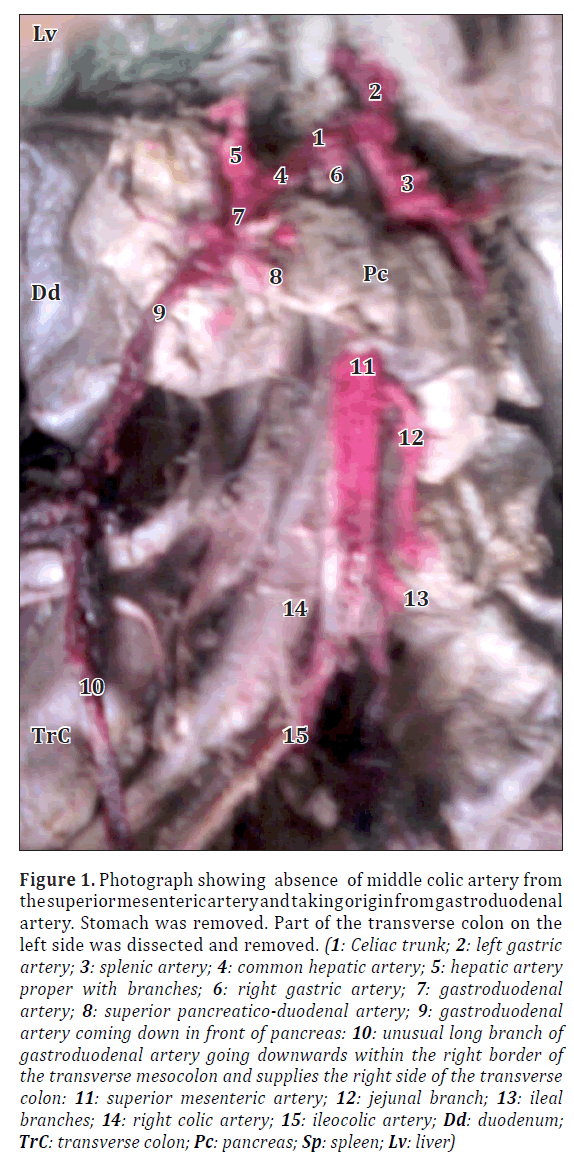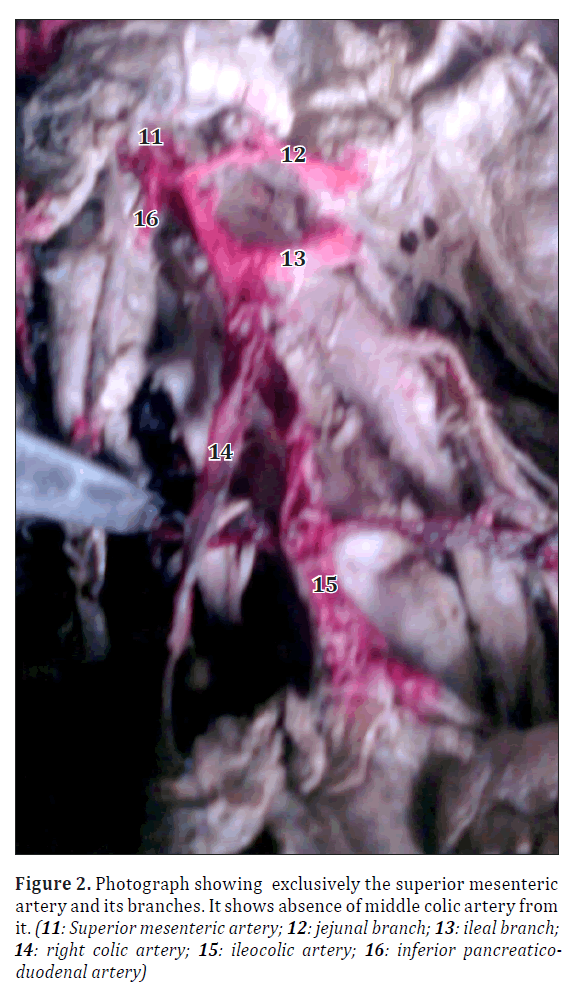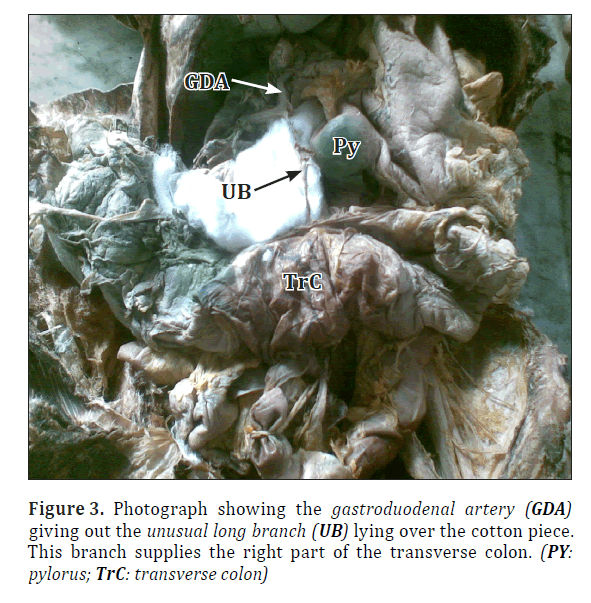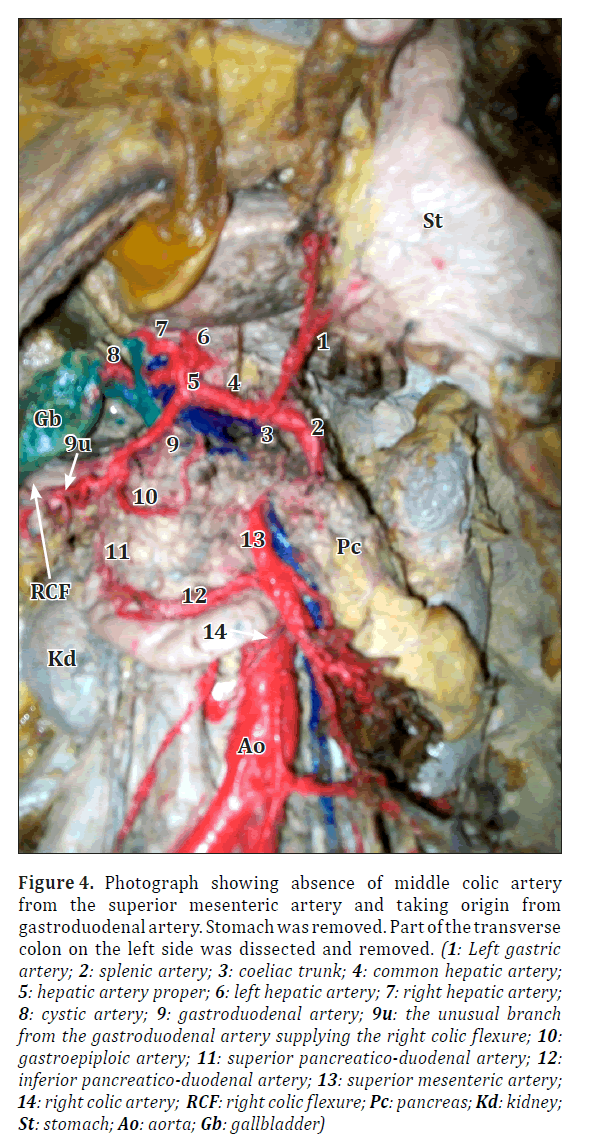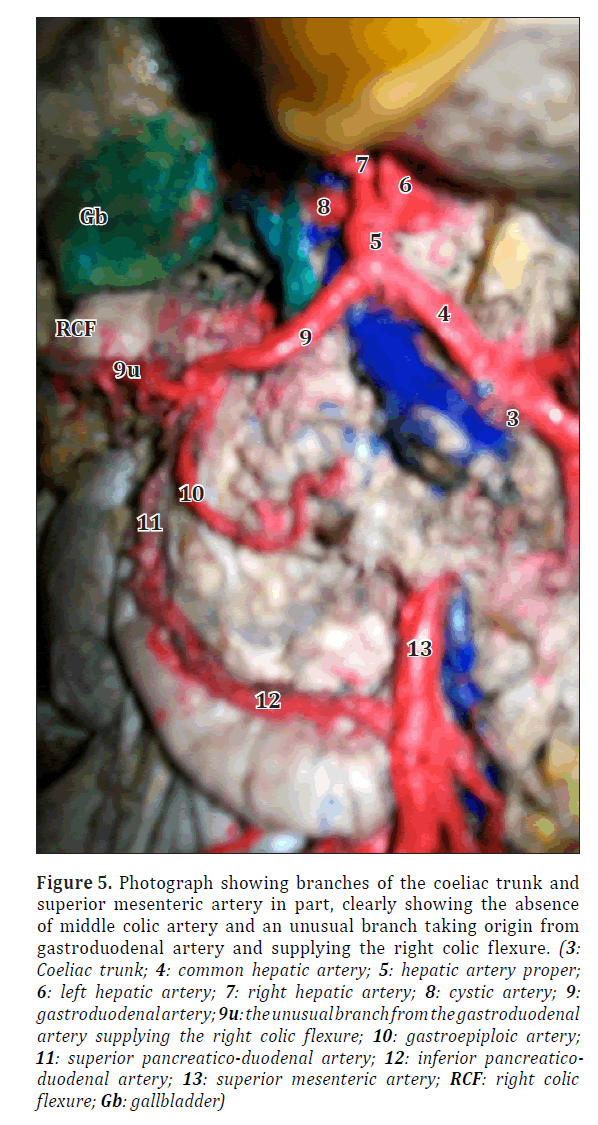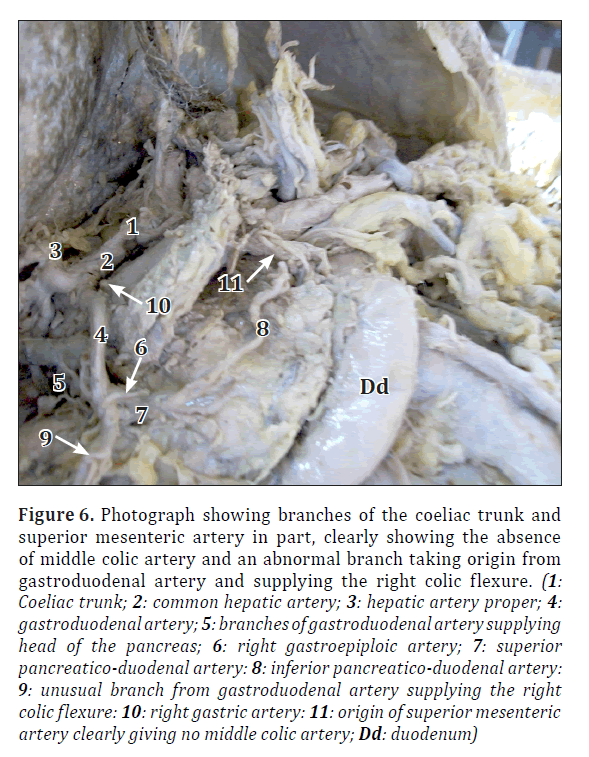Variant origin of the middle colic artery from the gastroduodenal artery
Gupta Indrajit1, Ray Ansuman2 and Basu Pallab3*
1Department of Anatomy, College of Medicine & Sagore Dutta Hospital, Kolkata, India
2Department of Anatomy, Calcutta National Medical College, Kolkata, India
3Department of Biochemistry, College of Medicine & Sagore Dutta Hospital, Kolkata, India
- *Corresponding Author:
- Basu Pallab, DCH, MD
Assistant Professor, Department of Biochemistry, College of Medicine & Sagore Dutta Hospital, West Bengal University of Health Sciences, Kolkata, India
Tel: +91 943 3232481
E-mail: basu_pallab@yahoo.co.in
Date of Received: September 24th, 2011
Date of Accepted: August 21st, 2012
Published Online: February 4th, 2013
© Int J Anat Var (IJAV). 2013; 6: 13–17.
[ft_below_content] =>Keywords
middle colic artery, gastroduodenal artery, arterial supply of transverse colon, colonic surgery, coeliac trunk
Introduction
Usually, the middle colic artery arises from the superior mesenteric artery or its major branches. However, previous cadaveric and radiological studies have observed its atypical origin and absence from the coelico-mesenteric system [1,2]. Such anatomical knowledge of arterial disposition is especially important in present day diagnostic angiographic procedures and minimal access surgery.
Case Report
During routine educational dissections among undergraduate students, an unusual origin of the middle colic artery was recorded in two female cadavers aged 68 years and 71 years, respectively. Gradual dissection of all the branches of coeliac trunk revealed that in case No. 1 (Case 1, Figure 1, 3), the gastroduodenal artery in addition to its normal branches, provided a 17 cm long vertical branch of 4 mm caliber, which stretched downwards in front of the head of the pancreas and third part of the duodenum to supply the right and middle part of the transverse colon. In case No. 2 (Case 2, Figure 1, 2, 3), the gastroduodenal artery provided, in addition to its normal branches, a branch which was 9 cm long and of 4 mm caliber and that supplied the right colic flexure and the right part of the transverse colon. Careful dissection of all the branches from the superior mesenteric artery demonstrated that the right colic and ileocolic arteries on the right side and the jejuno-ileal branches on the left side arose normally in both the cadavers but no middle colic artery was found taking origin directly or indirectly from superior mesenteric artery (Case 1, Figure 1, 2, 3, and Case 2, Figure 1, 2, 3). However, the origin of the middle colic artery was variable in both the cases. In both the cases, the compromised vascular pattern was supplemented by the variant middle colic artery that took origin from the gastroduodenal artery and supplied the right and the middle part of the transverse colon in case no. 1 and the right colic flexure with right part of transverse colon in case no. 2, respectively (Case 1, Figure 3, Case 2, Figure 1, 2). These apparently substituted the deficient middle colic arteries from the superior mesenteric arteries in both the cases.
Figure 1. Photograph showing absence of middle colic artery from the superior mesenteric artery and taking origin from gastroduodenal artery. Stomach was removed. Part of the transverse colon on the left side was dissected and removed. (1: Celiac trunk; 2: left gastric artery; 3: splenic artery; 4: common hepatic artery; 5: hepatic artery proper with branches; 6: right gastric artery; 7: gastroduodenal artery; 8: superior pancreatico-duodenal artery; 9: gastroduodenal artery coming down in front of pancreas: 10: unusual long branch of gastroduodenal artery going downwards within the right border of the transverse mesocolon and supplies the right side of the transverse colon: 11: superior mesenteric artery; 12: jejunal branch; 13: ileal branches; 14: right colic artery; 15: ileocolic artery; Dd: duodenum; TrC: transverse colon; Pc: pancreas; Sp: spleen; Lv: liver)
Discussion
Normally, the middle colic artery leaves the anterolateral aspect of superior mesenteric artery just inferior to the uncinate process of the pancreas and in front of the third part of duodenum and descends through the transverse mesocolon to divide into a right and left anastomotic branch [3]. It may arise high from the superior mesenteric and descend with this between the duodenum and pancreas, or may pass through the gland [4]. Gastroduodenal artery arises from the common hepatic artery behind or above the first part of duodenal artery.
It descends between first part of duodenum and pancreatic neck, then at the lower border of the first part of duodenum it gives right gastroepiploic and superior pancreaticoduodenal artery. Supraduodenal artery may arise from gastroduodenal artery. Gastroduodenal artery may arise from a trifurcation of right and left hepatic artery, superior mesenteric artery and left hepatic artery.
Earlier studies cite that the middle colic artery may be absent in between 3% and 5% of cases [2,5–7] and in infrequent instances, it may arise from the quadrifurcation and pentafurcation of the coeliac trunk or one of its branches [8].
A radioanatomical study among infants by Pereira et al. comprised of 50 cases and distinguished 5 fundamental types of vascular origin and two basic types of distribution of middle colic artery [9]. The middle colic artery originating atypically from the bed of coeliac Trunk was reported only in a single case [10]. Researchers have hitherto reported atypical origin of variant middle colic artery from the proximal segment of the splenic artery [1], splenic artery itself [11], common hepatic artery [12], hepatic artery [3,13] inferior mesenteric artery [3,14] inferior pancreaticoduodenal artery, [4] dorsal pancreatic artery, [3] left colic artery [3] as well as the gastroduodenal artery [4]. Garcia-Ruiz et al. [15] and Chitra have reported the presence of double middle colic arteries in their study of cadaveric dissections [8].
The middle colic artery may also arise as a middle mesenteric artery [16] or a third mesenteric artery [17] from the aorta between the superior and inferior mesenteric arteries.
In general, it is acknowledged that abdominal angina occurs only when there is a serious obstruction in at least 2 of the 3 splanchnic vessels, mesenteric arteries and the coeliac trunk. However, this common view does not take into account the anatomical variation of the arteries that supply blood to the intestine [18]. In higher origin of the artery its blood supply might be shut off in ligating the gastroduodenal artery, or the vessel could be directly injured, in operations on the head of the pancreas, as it passes across and behind this [4].
The arterial supply of large intestine is derived from both the superior and inferior mesenteric artery. The caecum, appendix, ascending colon, and right 2/3rd of the transverse colon (derived from the midgut) are supplied from ileocolic, right colic and middle colic branches of superior mesenteric artery. The marginal artery of Drummond of the colon is formed by the main trunks and the arcade arising from the ileocolic, right colic, middle colic and left colic artery. The anastomoses form between the main terminal branches running parallel to the colon to supply it. This marginal artery of colon may get hugely dilated, when the superior mesenteric artery is progressively occluded, to supply the majority of the midgut. In both of our cases the middle colic artery was unavailable to take part in forming such anastomosis [3].
The present study reports 2 cases of middle colic artery arising from the gastroduodenal artery instead of its usual origin from the superior mesenteric artery, an unusual variation encountered in literature or clinical surgery. It was interesting to note that both the cases were observed in female cadavers, which leaves the window of future scrutiny on the basis of gender predilection of such variation.
Embryological Background
During fetal development, both primitive dorsal aortae provides three sets of paired segmental branches, viz., a ventral set for the gastrointestinal tube, a somatic intersegmental set to the body wall and the neural tube and a lateral splanchnic set for derivatives of the intermediate mesoderm. After fusion of the dorsal aortae cranio-caudally, the ventral branches are also fused to form a series of unpaired segmental vessels which divide into ascending and descending rami along the dorsal aspect of the developing gastrointestinal tube and eventually forms a dorsal and ventral anastomosis along the gut. Due to such extensive anastomosis, the need of numerous ventral splanchnic branches reduces and ultimately only three trunks persist, namely the coeliac trunk for the foregut, superior and inferior mesenteric artery for the midgut and hindgut, respectively.
Figure 4. Photograph showing absence of middle colic artery from the superior mesenteric artery and taking origin from gastroduodenal artery. Stomach was removed. Part of the transverse colon on the left side was dissected and removed. (1: Left gastric artery; 2: splenic artery; 3: coeliac trunk; 4: common hepatic artery; 5: hepatic artery proper; 6: left hepatic artery; 7: right hepatic artery; 8: cystic artery; 9: gastroduodenal artery; 9u: the unusual branch from the gastroduodenal artery supplying the right colic flexure; 10: gastroepiploic artery; 11: superior pancreatico-duodenal artery; 12: inferior pancreatico-duodenal artery; 13: superior mesenteric artery; 14: right colic artery; RCF: right colic flexure; Pc: pancreas; Kd: kidney; St: stomach; Ao: aorta; Gb: gallbladder)
Figure 5. Photograph showing branches of the coeliac trunk and superior mesenteric artery in part, clearly showing the absence of middle colic artery and an unusual branch taking origin from gastroduodenal artery and supplying the right colic flexure. (3: Coeliac trunk; 4: common hepatic artery; 5: hepatic artery proper; 6: left hepatic artery; 7: right hepatic artery; 8: cystic artery; 9: gastroduodenal artery; 9u: the unusual branch from the gastroduodenal artery supplying the right colic flexure; 10: gastroepiploic artery; 11: superior pancreatico-duodenal artery; 12: inferior pancreatico-duodenal artery; 13: superior mesenteric artery; RCF: right colic flexure; Gb: gallbladder)
Some of the ventral and dorsal anastomotic branches lose their connection and develop as branches of the three main arteries. The dorsal anastomosis persists as gastroepiploic, inferior pancreaticoduodenal and marginal arteries of the large gut while the ventral anastomosis forms right and left gastric arteries. A middle colic artery originating from a coeliac trunk was considered as evidence for the ventral longitudinal anastomosis of the primitive vitelline arteries in the embryo [19].
Meanwhile the foregut develops into the stomach, and duodenum, the midgut loop herniates through the umbilicus and the hepatic bud and dorsal and ventral pancreatic bud develops.
During rotation and re-fixation of the foregut, the ventral pancreatic bud fuses with the dorsal one along with their arterial supply, so that the superior pancreaticoduodenal branch along with the ventral anastomosis lies behind the neck of the gastroduodenal artery. Hence in absence of the middle colic artery any branch e.g., gastroduodenal or superior pancreaticoduodenal branch of coeliac trunk may supply the right part of transverse colon (rami).
Figure 6. Photograph showing branches of the coeliac trunk and superior mesenteric artery in part, clearly showing the absence of middle colic artery and an abnormal branch taking origin from gastroduodenal artery and supplying the right colic flexure. (1: Coeliac trunk; 2: common hepatic artery; 3: hepatic artery proper; 4: gastroduodenal artery; 5: branches of gastroduodenal artery supplying head of the pancreas; 6: right gastroepiploic artery; 7: superior pancreatico-duodenal artery: 8: inferior pancreatico-duodenal artery: 9: unusual branch from gastroduodenal artery supplying the right colic flexure: 10: right gastric artery: 11: origin of superior mesenteric artery clearly giving no middle colic artery; Dd: duodenum)
References
- Amonoo-Kuofi HS, el-Badawi MG, el-Naggar ME. Anomalous origins of colic arteries. Clin Anat. 1995; 8: 288–293.
- Michels NA, Siddharth P, Kornblith PL, Parke WW. The variant blood supply to the small and large intestines: its importance in regional resections. A new anatomic study based on four hundred dissections with a complete review of the literature. J Int Coll Surg. 1962; 39: 127–170.
- Standring S, Borley NR, Collins P, Crossman AR, Gatzoulis MA, Healy JC, Johnson D, Mahadevan V, Newell RLM, Wigley CB. Large Intestine. In: Standring S, Borley NR, Collins P, Crossman AR, Gatzoulis MA, Healy JC, Johnson D, Mahadevan V, Newell RLM, Wigley CB, eds. Gray’s Anatomy. The Anatomical Basis of Clinical Practice. 4th Ed. Churchill Livingstone, Elsevier, Printed in China, 2008: 1140–1146.
- Hollinshead WH. Anatomy for Surgeons. Vol 1. 2nd Ed., New York, Harper & Row Publishers. 1971; 416–495
- Mayo CW. Blood supply of the colon: surgical considerations. Surg Clin North Am. 1955; 35: 1117–1121.
- Steward JA, Rankin FW. Blood supply of the large intestine: its surgical considerations. Arch Surg. 1933; 26: 843–891.
- Sonneland J, Anson BJ, Beaton LE. Surgical anatomy of the arterial supply to the colon from the superior mesenteric artery based upon a study of 600 specimens. Surg Gynecol Obstet. 1958; 106: 385–398.
- Chitra R. Clinically relevant variations of the coeliac trunk. Singapore Med J. 2010; 51: 216–219.
- Pereira WF, Ures S, Prates JC. Anatomo-radiological study of the middle colic artery in children from 0 to 1 year. Arq Gastroenterol. 1984; 21: 187–195. (Portuguese)
- Makowski M, Bartlewicz J, Krzanowski M, Nizankowski R, Szczeklik A. Advanced abdominal angina due to atherosclerosis with atypical celiac arteries. Pol Arch Med Wewn. 2000; 104: 859–862. (Polish)
- Murokami T, Mabuchi M, Giuvarasteanu I, Kikuta A, Ohtsuka A. Coexistence of rare arteries in the human celiaco-mesenteric system. Acta Med Okayama. 1998; 52: 239–244.
- Wadhwa S, Barua MP. Anomalous middle colic artery originating from common hepatic artery: a case report. Clin Anat. 2008; 21: 798–799.
- Shoumura S, Emura S, Utsumi M, Chen H, Hayakawa O, Yamahira T, Isono H. Anatomical study on the branches of the celiac trunk (IV). Comparison of the findings with Adachi’s classification. Kaibogaku Zasshi. 1991; 66: 452–461.
- Benton RS, Cotter WB. A hitherto undocumented variation of the inferior mesenteric artery in man. Anat Rec. 1963; 145: 171–173.
- Garcia-Ruiz A, Milsom JW, Ludwig KA, Marchesa P. Right colonic arterial anatomy. Implications for laparoscopic surgery. Dis Colon Rectum. 1996; 39: 906–911.
- Yoshida T, Suzuki S, Sato T. Middle mesenteric artery; an anomalous origin of a middle colic artery. Surg Radiol Anat. 1993; 15: 361–363.
- Lawdahl RB, Keller FS. The middle mesenteric artery. Radiology. 1987; 165: 371–372.
- Yildirim M, Celik HH, Yildiz Z, Tatar I, Aldur MM. The middle colic artery originating from the coeliac trunk. Folia Morphol (Warsz). 2004; 63: 363–365.
- Tandler J. Zur Entwicklungsgeschichte der menschlichen Darmarterien. Anatomy and Embryology. 1903; 23: 188–210. (German)
Gupta Indrajit1, Ray Ansuman2 and Basu Pallab3*
1Department of Anatomy, College of Medicine & Sagore Dutta Hospital, Kolkata, India
2Department of Anatomy, Calcutta National Medical College, Kolkata, India
3Department of Biochemistry, College of Medicine & Sagore Dutta Hospital, Kolkata, India
- *Corresponding Author:
- Basu Pallab, DCH, MD
Assistant Professor, Department of Biochemistry, College of Medicine & Sagore Dutta Hospital, West Bengal University of Health Sciences, Kolkata, India
Tel: +91 943 3232481
E-mail: basu_pallab@yahoo.co.in
Date of Received: September 24th, 2011
Date of Accepted: August 21st, 2012
Published Online: February 4th, 2013
© Int J Anat Var (IJAV). 2013; 6: 13–17.
Abstract
A detailed anatomical knowledge of the normal and variant blood supply of the colon remains an essential prerequisite in modern day advanced abdominal surgery viz., abdominopelvic resection, carcinoma of colon and pancreatic surgery. The colon receives its blood supply from the branches of superior and inferior mesenteric arteries. Though certain studies have been devoted to assess arterial variations, only a minority of previous studies report such incidence. The present study reports 2 cases of middle colic artery arising from the gastroduodenal artery instead of its usual origin from the superior mesenteric artery, an unusual variation encountered in literature or clinical surgery.
-Keywords
middle colic artery, gastroduodenal artery, arterial supply of transverse colon, colonic surgery, coeliac trunk
Introduction
Usually, the middle colic artery arises from the superior mesenteric artery or its major branches. However, previous cadaveric and radiological studies have observed its atypical origin and absence from the coelico-mesenteric system [1,2]. Such anatomical knowledge of arterial disposition is especially important in present day diagnostic angiographic procedures and minimal access surgery.
Case Report
During routine educational dissections among undergraduate students, an unusual origin of the middle colic artery was recorded in two female cadavers aged 68 years and 71 years, respectively. Gradual dissection of all the branches of coeliac trunk revealed that in case No. 1 (Case 1, Figure 1, 3), the gastroduodenal artery in addition to its normal branches, provided a 17 cm long vertical branch of 4 mm caliber, which stretched downwards in front of the head of the pancreas and third part of the duodenum to supply the right and middle part of the transverse colon. In case No. 2 (Case 2, Figure 1, 2, 3), the gastroduodenal artery provided, in addition to its normal branches, a branch which was 9 cm long and of 4 mm caliber and that supplied the right colic flexure and the right part of the transverse colon. Careful dissection of all the branches from the superior mesenteric artery demonstrated that the right colic and ileocolic arteries on the right side and the jejuno-ileal branches on the left side arose normally in both the cadavers but no middle colic artery was found taking origin directly or indirectly from superior mesenteric artery (Case 1, Figure 1, 2, 3, and Case 2, Figure 1, 2, 3). However, the origin of the middle colic artery was variable in both the cases. In both the cases, the compromised vascular pattern was supplemented by the variant middle colic artery that took origin from the gastroduodenal artery and supplied the right and the middle part of the transverse colon in case no. 1 and the right colic flexure with right part of transverse colon in case no. 2, respectively (Case 1, Figure 3, Case 2, Figure 1, 2). These apparently substituted the deficient middle colic arteries from the superior mesenteric arteries in both the cases.
Figure 1. Photograph showing absence of middle colic artery from the superior mesenteric artery and taking origin from gastroduodenal artery. Stomach was removed. Part of the transverse colon on the left side was dissected and removed. (1: Celiac trunk; 2: left gastric artery; 3: splenic artery; 4: common hepatic artery; 5: hepatic artery proper with branches; 6: right gastric artery; 7: gastroduodenal artery; 8: superior pancreatico-duodenal artery; 9: gastroduodenal artery coming down in front of pancreas: 10: unusual long branch of gastroduodenal artery going downwards within the right border of the transverse mesocolon and supplies the right side of the transverse colon: 11: superior mesenteric artery; 12: jejunal branch; 13: ileal branches; 14: right colic artery; 15: ileocolic artery; Dd: duodenum; TrC: transverse colon; Pc: pancreas; Sp: spleen; Lv: liver)
Discussion
Normally, the middle colic artery leaves the anterolateral aspect of superior mesenteric artery just inferior to the uncinate process of the pancreas and in front of the third part of duodenum and descends through the transverse mesocolon to divide into a right and left anastomotic branch [3]. It may arise high from the superior mesenteric and descend with this between the duodenum and pancreas, or may pass through the gland [4]. Gastroduodenal artery arises from the common hepatic artery behind or above the first part of duodenal artery.
It descends between first part of duodenum and pancreatic neck, then at the lower border of the first part of duodenum it gives right gastroepiploic and superior pancreaticoduodenal artery. Supraduodenal artery may arise from gastroduodenal artery. Gastroduodenal artery may arise from a trifurcation of right and left hepatic artery, superior mesenteric artery and left hepatic artery.
Earlier studies cite that the middle colic artery may be absent in between 3% and 5% of cases [2,5–7] and in infrequent instances, it may arise from the quadrifurcation and pentafurcation of the coeliac trunk or one of its branches [8].
A radioanatomical study among infants by Pereira et al. comprised of 50 cases and distinguished 5 fundamental types of vascular origin and two basic types of distribution of middle colic artery [9]. The middle colic artery originating atypically from the bed of coeliac Trunk was reported only in a single case [10]. Researchers have hitherto reported atypical origin of variant middle colic artery from the proximal segment of the splenic artery [1], splenic artery itself [11], common hepatic artery [12], hepatic artery [3,13] inferior mesenteric artery [3,14] inferior pancreaticoduodenal artery, [4] dorsal pancreatic artery, [3] left colic artery [3] as well as the gastroduodenal artery [4]. Garcia-Ruiz et al. [15] and Chitra have reported the presence of double middle colic arteries in their study of cadaveric dissections [8].
The middle colic artery may also arise as a middle mesenteric artery [16] or a third mesenteric artery [17] from the aorta between the superior and inferior mesenteric arteries.
In general, it is acknowledged that abdominal angina occurs only when there is a serious obstruction in at least 2 of the 3 splanchnic vessels, mesenteric arteries and the coeliac trunk. However, this common view does not take into account the anatomical variation of the arteries that supply blood to the intestine [18]. In higher origin of the artery its blood supply might be shut off in ligating the gastroduodenal artery, or the vessel could be directly injured, in operations on the head of the pancreas, as it passes across and behind this [4].
The arterial supply of large intestine is derived from both the superior and inferior mesenteric artery. The caecum, appendix, ascending colon, and right 2/3rd of the transverse colon (derived from the midgut) are supplied from ileocolic, right colic and middle colic branches of superior mesenteric artery. The marginal artery of Drummond of the colon is formed by the main trunks and the arcade arising from the ileocolic, right colic, middle colic and left colic artery. The anastomoses form between the main terminal branches running parallel to the colon to supply it. This marginal artery of colon may get hugely dilated, when the superior mesenteric artery is progressively occluded, to supply the majority of the midgut. In both of our cases the middle colic artery was unavailable to take part in forming such anastomosis [3].
The present study reports 2 cases of middle colic artery arising from the gastroduodenal artery instead of its usual origin from the superior mesenteric artery, an unusual variation encountered in literature or clinical surgery. It was interesting to note that both the cases were observed in female cadavers, which leaves the window of future scrutiny on the basis of gender predilection of such variation.
Embryological Background
During fetal development, both primitive dorsal aortae provides three sets of paired segmental branches, viz., a ventral set for the gastrointestinal tube, a somatic intersegmental set to the body wall and the neural tube and a lateral splanchnic set for derivatives of the intermediate mesoderm. After fusion of the dorsal aortae cranio-caudally, the ventral branches are also fused to form a series of unpaired segmental vessels which divide into ascending and descending rami along the dorsal aspect of the developing gastrointestinal tube and eventually forms a dorsal and ventral anastomosis along the gut. Due to such extensive anastomosis, the need of numerous ventral splanchnic branches reduces and ultimately only three trunks persist, namely the coeliac trunk for the foregut, superior and inferior mesenteric artery for the midgut and hindgut, respectively.
Figure 4. Photograph showing absence of middle colic artery from the superior mesenteric artery and taking origin from gastroduodenal artery. Stomach was removed. Part of the transverse colon on the left side was dissected and removed. (1: Left gastric artery; 2: splenic artery; 3: coeliac trunk; 4: common hepatic artery; 5: hepatic artery proper; 6: left hepatic artery; 7: right hepatic artery; 8: cystic artery; 9: gastroduodenal artery; 9u: the unusual branch from the gastroduodenal artery supplying the right colic flexure; 10: gastroepiploic artery; 11: superior pancreatico-duodenal artery; 12: inferior pancreatico-duodenal artery; 13: superior mesenteric artery; 14: right colic artery; RCF: right colic flexure; Pc: pancreas; Kd: kidney; St: stomach; Ao: aorta; Gb: gallbladder)
Figure 5. Photograph showing branches of the coeliac trunk and superior mesenteric artery in part, clearly showing the absence of middle colic artery and an unusual branch taking origin from gastroduodenal artery and supplying the right colic flexure. (3: Coeliac trunk; 4: common hepatic artery; 5: hepatic artery proper; 6: left hepatic artery; 7: right hepatic artery; 8: cystic artery; 9: gastroduodenal artery; 9u: the unusual branch from the gastroduodenal artery supplying the right colic flexure; 10: gastroepiploic artery; 11: superior pancreatico-duodenal artery; 12: inferior pancreatico-duodenal artery; 13: superior mesenteric artery; RCF: right colic flexure; Gb: gallbladder)
Some of the ventral and dorsal anastomotic branches lose their connection and develop as branches of the three main arteries. The dorsal anastomosis persists as gastroepiploic, inferior pancreaticoduodenal and marginal arteries of the large gut while the ventral anastomosis forms right and left gastric arteries. A middle colic artery originating from a coeliac trunk was considered as evidence for the ventral longitudinal anastomosis of the primitive vitelline arteries in the embryo [19].
Meanwhile the foregut develops into the stomach, and duodenum, the midgut loop herniates through the umbilicus and the hepatic bud and dorsal and ventral pancreatic bud develops.
During rotation and re-fixation of the foregut, the ventral pancreatic bud fuses with the dorsal one along with their arterial supply, so that the superior pancreaticoduodenal branch along with the ventral anastomosis lies behind the neck of the gastroduodenal artery. Hence in absence of the middle colic artery any branch e.g., gastroduodenal or superior pancreaticoduodenal branch of coeliac trunk may supply the right part of transverse colon (rami).
Figure 6. Photograph showing branches of the coeliac trunk and superior mesenteric artery in part, clearly showing the absence of middle colic artery and an abnormal branch taking origin from gastroduodenal artery and supplying the right colic flexure. (1: Coeliac trunk; 2: common hepatic artery; 3: hepatic artery proper; 4: gastroduodenal artery; 5: branches of gastroduodenal artery supplying head of the pancreas; 6: right gastroepiploic artery; 7: superior pancreatico-duodenal artery: 8: inferior pancreatico-duodenal artery: 9: unusual branch from gastroduodenal artery supplying the right colic flexure: 10: right gastric artery: 11: origin of superior mesenteric artery clearly giving no middle colic artery; Dd: duodenum)
References
- Amonoo-Kuofi HS, el-Badawi MG, el-Naggar ME. Anomalous origins of colic arteries. Clin Anat. 1995; 8: 288–293.
- Michels NA, Siddharth P, Kornblith PL, Parke WW. The variant blood supply to the small and large intestines: its importance in regional resections. A new anatomic study based on four hundred dissections with a complete review of the literature. J Int Coll Surg. 1962; 39: 127–170.
- Standring S, Borley NR, Collins P, Crossman AR, Gatzoulis MA, Healy JC, Johnson D, Mahadevan V, Newell RLM, Wigley CB. Large Intestine. In: Standring S, Borley NR, Collins P, Crossman AR, Gatzoulis MA, Healy JC, Johnson D, Mahadevan V, Newell RLM, Wigley CB, eds. Gray’s Anatomy. The Anatomical Basis of Clinical Practice. 4th Ed. Churchill Livingstone, Elsevier, Printed in China, 2008: 1140–1146.
- Hollinshead WH. Anatomy for Surgeons. Vol 1. 2nd Ed., New York, Harper & Row Publishers. 1971; 416–495
- Mayo CW. Blood supply of the colon: surgical considerations. Surg Clin North Am. 1955; 35: 1117–1121.
- Steward JA, Rankin FW. Blood supply of the large intestine: its surgical considerations. Arch Surg. 1933; 26: 843–891.
- Sonneland J, Anson BJ, Beaton LE. Surgical anatomy of the arterial supply to the colon from the superior mesenteric artery based upon a study of 600 specimens. Surg Gynecol Obstet. 1958; 106: 385–398.
- Chitra R. Clinically relevant variations of the coeliac trunk. Singapore Med J. 2010; 51: 216–219.
- Pereira WF, Ures S, Prates JC. Anatomo-radiological study of the middle colic artery in children from 0 to 1 year. Arq Gastroenterol. 1984; 21: 187–195. (Portuguese)
- Makowski M, Bartlewicz J, Krzanowski M, Nizankowski R, Szczeklik A. Advanced abdominal angina due to atherosclerosis with atypical celiac arteries. Pol Arch Med Wewn. 2000; 104: 859–862. (Polish)
- Murokami T, Mabuchi M, Giuvarasteanu I, Kikuta A, Ohtsuka A. Coexistence of rare arteries in the human celiaco-mesenteric system. Acta Med Okayama. 1998; 52: 239–244.
- Wadhwa S, Barua MP. Anomalous middle colic artery originating from common hepatic artery: a case report. Clin Anat. 2008; 21: 798–799.
- Shoumura S, Emura S, Utsumi M, Chen H, Hayakawa O, Yamahira T, Isono H. Anatomical study on the branches of the celiac trunk (IV). Comparison of the findings with Adachi’s classification. Kaibogaku Zasshi. 1991; 66: 452–461.
- Benton RS, Cotter WB. A hitherto undocumented variation of the inferior mesenteric artery in man. Anat Rec. 1963; 145: 171–173.
- Garcia-Ruiz A, Milsom JW, Ludwig KA, Marchesa P. Right colonic arterial anatomy. Implications for laparoscopic surgery. Dis Colon Rectum. 1996; 39: 906–911.
- Yoshida T, Suzuki S, Sato T. Middle mesenteric artery; an anomalous origin of a middle colic artery. Surg Radiol Anat. 1993; 15: 361–363.
- Lawdahl RB, Keller FS. The middle mesenteric artery. Radiology. 1987; 165: 371–372.
- Yildirim M, Celik HH, Yildiz Z, Tatar I, Aldur MM. The middle colic artery originating from the coeliac trunk. Folia Morphol (Warsz). 2004; 63: 363–365.
- Tandler J. Zur Entwicklungsgeschichte der menschlichen Darmarterien. Anatomy and Embryology. 1903; 23: 188–210. (German)




